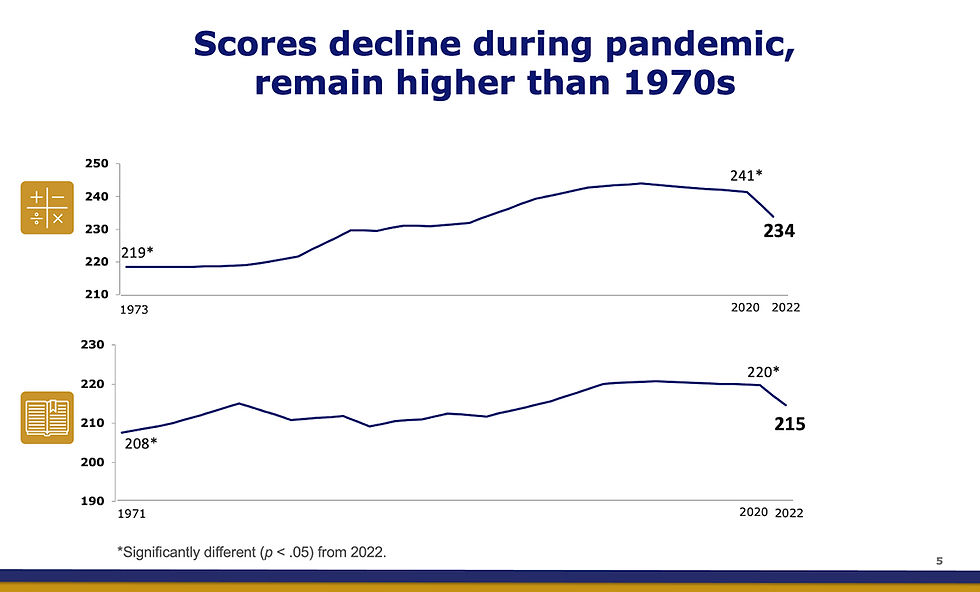Down, down, down
- Joanne Jacobs

- Sep 1, 2022
- 2 min read
The pandemic -- and the response to the pandemic -- was a disaster for students. We knew that, but now we really know that. Reading and math scores fell sharply for 9-year-old students from 2020 to 2022, according to the National Assessment of Educational Progress (NAEP) known as the Nation's Report Card.

It's the largest drop in NAEP's 50-year history, putting students in 2022 at the levels seen two decades earlier.
The average math score declined by seven points since 2020 -- 12 points for the lowest-scoring 9-year-olds. High achievers, who'd been improving before the pandemic, lost three to five points. “Everyone is dropping," said Peggy Carr, commissioner of the National Center for Education Statistics. "But the students at the bottom are dropping faster.”
Reading score for 9-year-olds declined five points with the lowest performers losing 10 points and the highest losing two points.
"Mathematics scores declined five points for White students, 13 points for Black students, and eight points for Hispanic students," NAEP reports. "Reading scores declined six points for White, Black, and Hispanic students."

Scores held steady for Asian/Pacific Islander students, American Indian/Alaska Native students and multi-racial students.
Most students spent time learning remotely, but it was more of a challenge for some than others.
-- 83 percent of higher-performing students in both reading and mathematics (students performing at or above the 75th percentile) had access to a desktop computer, laptop, or tablet all the time, compared to 61 percent of lower-performing students (those performing below the 25th percentile);
-- 60 percent of higher-performing students in mathematics said their teacher was available to help with schoolwork at least 1-2 times per week, compared to 39 percent of lower-performing students.
Achievement gaps were growing before the pandemic, writes Kalyn Belsha in Chalkbeat. Now it's worse.
So far, other state and national tests suggest elementary students are starting to rebound in reading and math she writes. "But by some measures, middle schoolers are recovering more slowly, or not at all — raising concerns about whether enough is being done to support older students, who have less time to catch up."
In late October, NAEP will release data on how older students are doing, writes Belsha.
"This was a man-made disaster, not an inevitable consequence of COVID," said Kathleen Porter-Magee, superintendent of Partnership Schools, a network of urban Catholic schools. "Those who have been fighting to reopen schools since Fall 2020 knew that school was essential, that children faced the lowest risk of severe illness, and that children faced the most severe consequences of the prolonged shut down."






I'm sure this is shocking to some people, but not to anyone who thinks about it or who is familiar with what was going on during distance teaching. I call it distance teaching as opposed to distance learning because, well, you know.... (mrmillermathteacher)